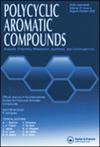Click Chemistry-Based Synthesis, Characterization, and DFT Studies of Some Novel 2-Acetylphenoxy-1,2,3-Triazoles
IF 2.4
3区 化学
Q2 CHEMISTRY, ORGANIC
引用次数: 0
Abstract
A series of the new 1,2,3-triazole-acetophenone hybrid system are synthesized from the click reaction between 1-(2-(prop-2-yn-1-yloxy)phenyl)ethan-1-one 1 and different azido benzene derivatives 2-7. All compounds are characterized by 1H NMR, 13C NMR, mass spectra, and elemental analyses. Field Emission Scanning Electron Microscope (FESEM) detected highly ordered aggregations, and the morphology of the compounds was determined, directed by van der Waals (vdW) forces and π-π stacking interactions. The Gaussian 09 and Gaussian view 6.0 softwares are used for all Density Functional Theory (DFT) calculations at the B3LYP. Band gap, molecular softness, electronegativity, and electrophilicity measurements show that molecule 9 is a soft molecule with higher polarizability, lower kinetic stability, and more chemical reactivity than the other molecules, which tend to be the most stable and least reactive. The molecules can be divided into two categories based on their chemical potential values: Although compound 9 looks to have more activity, compounds 8, 10, 11, 12, and 13 often have the best stability and least reactivity. According to the MEPs, the nitrogen and oxygen atoms are the electronegative potential sites in all compounds, while the hydrogen atoms in the alkyl and aromatic cyclic groups are the electropositive potential sites.
- Download: Download high-res image (396KB)
- Download: Download full-size image
基于点击化学的一些新型 2-乙酰基苯氧基-1,2,3-三唑的合成、表征和 DFT 研究
通过 1-(2-(丙-2-炔-1-氧基)苯基)乙-1-酮 1 与不同叠氮苯衍生物 2-7 的点击反应,合成了一系列新的 1,2,3-三唑-苯乙酮杂化体系。所有化合物均通过 1H NMR、13C NMR、质谱和元素分析进行表征。场发射扫描电子显微镜(FESEM)检测到了高度有序的聚集,并在范德华力(vdW)和π-π堆积相互作用的引导下确定了化合物的形态。所有密度泛函理论(DFT)计算都使用了高斯 09 和高斯视图 6.0 软件,B3LYP。带隙、分子软度、电负性和亲电性测量结果表明,分子 9 是一种软分子,与其他分子相比,极化性较高,动力学稳定性较低,化学反应性较强,而其他分子往往是最稳定和反应性最低的。根据化学势值,分子可分为两类:虽然化合物 9 看起来活性更高,但化合物 8、10、11、12 和 13 通常稳定性最好,反应性最低。根据化学势值,氮原子和氧原子是所有化合物中的电负势位点,而烷基和芳香环基中的氢原子则是电正势位点:下载高清图片 (396KB)Download:下载全尺寸图片
本文章由计算机程序翻译,如有差异,请以英文原文为准。
求助全文
约1分钟内获得全文
求助全文
来源期刊

Polycyclic Aromatic Compounds
化学-有机化学
CiteScore
3.70
自引率
20.80%
发文量
412
审稿时长
3 months
期刊介绍:
The purpose of Polycyclic Aromatic Compounds is to provide an international and interdisciplinary forum for all aspects of research related to polycyclic aromatic compounds (PAC). Topics range from fundamental research in chemistry (including synthetic and theoretical chemistry) and physics (including astrophysics), as well as thermodynamics, spectroscopy, analytical methods, and biology to applied studies in environmental science, biochemistry, toxicology, and industry. Polycyclic Aromatic Compounds has an outstanding Editorial Board and offers a rapid and efficient peer review process, as well as a flexible open access policy.
 求助内容:
求助内容: 应助结果提醒方式:
应助结果提醒方式:


